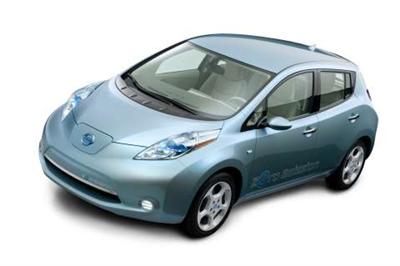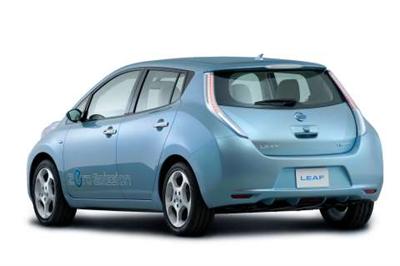Nissan Leaf confirmed for Australia
|
|
|

 Nissan's electric car, the Leaf,
Nissan's electric car, the Leaf,
is expected in Australia during 2012.
|
|
|
Home >
News >
Nissan
16th March, 2010
The Nissan Leaf will deliver a new level of personal
mobility combined with zero emission environmental responsibility when it goes on sale overseas later
this year.
“The world is changing and Nissan is a catalyst for that change,” said Pierre Loing, Vice
President, Product and Advance Planning, Nissan International SA previewing the Nissan Leaf at the recent
2010 Geneva Motor Show.
“The Nissan Leaf is the world’s first competitively-priced, mass-produced electric vehicle from a
mainstream manufacturer. It is serious car, a real car, and the right car for the times.”
Styled as a clean sheet design, Nissan Leaf is a roomy five-seater family hatchback offering all the
space, practicality and performance of any of its conventional rivals… but with one notable difference.
It is a pure EV, promising no tailpipe emissions and low running costs.
Sales will begin in the USA, Japan and in selected European markets in late 2010, with Australian
deliveries expected to begin in 2012.
“Our car had to be the world’s first, medium-size, practical EV that motorists could afford and
would want to use every day. And that’s what we’ve created,” said Masato Inoue, Product Chief
Designer. “The styling will identify not only Nissan Leaf, but also the owner as a participant in
the new era of zero-emission mobility.”
Nissan Leaf is just the first in a range of EVs due from the company and from Nissan’s Alliance
partner Renault. A delivery van, a small crossover SUV and even a unique motorcycle that leans are other
variants under investigation.
Through their development of Nissan Leaf, Nissan and Renault have gained the initiative on key ‘Save
the Planet’ technology.
Rather than devote time and resources on hybrid power or electric conversion of existing vehicles,
the Renault Nissan Alliance decided to 'leapfrog' partial solutions to develop a practical, zero
emission EV from the outset.
In Europe, sales will initially be to stakeholders, fleet operators and private customers. Among the
stakeholder customers are major rental companies Europcar and Hertz, both of whom have signed MoUs with
Nissan.
In Australia, Nissan has signed MoUs with the States of New South Wales and Victoria to pave the way
for the introduction of Nissan Leaf.
Nissan Australia CEO, Dan Thompson said the memorandums were designed to help the company explore the
path to emission-free motoring with the government instrumentalities concerned.
“A reliable and omnipresent recharging network is a desired complement of electric vehicle
mobility and we hope these discussions will contribute towards that realisation,” said Thompson.
He said Nissan was also investigating different sales options, including purchase of the car and lease
of the battery and leasing of both car and battery.
“Whichever route is chosen, the end result, once government incentives and total ownership running
costs have been factored in and we will be able to provide a car at an affordable price in line with
comparable vehicles in its segment.”
“As well as selling to fleet customers, we will also be targeting private customers, early adopters
who understand the benefits of zero emission vehicles,” he said.
The first cars will be manufactured at Nissan’s plant in Oppama, Japan, with an initial annual
capacity of 50,000 units, but production will start at a second plant in Smyrna, Tennessee (USA) in 2012
to meet anticipated global demand.
Battery manufacture has already started in Japan, but Nissan has announced that new battery plants will
be established in Portugal and the UK, as well as at Smyrna, USA in the near future.
When full capacity is reached, the Smyrna plant alone will produce 150,000 units annually. Nissan also
plans to manufacture the cars in Europe in the future.
The electric motor is ‘fuelled’ by an advanced Nissan-developed laminated lithium-ion battery with a
power output of more than 90 kW. The 48-module battery is mounted under the seats and floor of Nissan Leaf.
Regenerative energy reclaimed under braking and coasting is fed directly to the battery to ensure a
minimum waste of energy.
Nissan has been developing the lithium-ion battery for EVs since 1992, with the main focus on reducing
the size of the battery while simultaneously increasing power and capacity.
The company’s leading role in development of this new battery technology gave it the confidence to
pioneer the zero emission EV road:
- Nissan Leaf’s lithium-ion battery has twice the energy density of a conventional lead-acid battery,
doubling the vehicle’s cruising distance under comparable conditions
- it is lighter and more compact, so takes up less space, while its thinner laminated structure allows
greater layout flexibility and better temperature control
- it also lasts longer and is easier to recycle at the end of its life.
Using a DC 50 kW quick charger, the battery can be charged to up to 80 per cent of its capacity in
under 30 minutes. Until quick charging posts are commonplace, however, it is expected that most owners
will charge their vehicles either at home or at work using a domestic 220~240V system. A full charge
from 0 to 100 per cent under these circumstances takes about eight hours.
A full charge delivers a potential range of 160 km, which will satisfy the daily driving demands of
most customers according to Nissan’s global research.
The recharging socket for normal charging and quick charging is conveniently placed on Nissan Leaf’s
'nose' under a ‘fuel filler flap’ adorned with the Nissan logo.
The battery will still have between 70-80 per cent of its original capacity after 10 years’ use.
Nissan is investigating potential uses for the batteries after their useful life in vehicles is over and
there are extensive recycling plans in place to ensure precious materials can be reused. Overall, more
than 95 per cent of Nissan Leaf can be recycled.
“One of our jobs is to prove to every potential customer that the present range is adequate for
their needs and to make them understand that the genuine benefits of EV travel more than outweigh the
perceived problem,” said Nissan’s Product Chief Designer, Masato Inoue.
Built on a new platform, Nissan Leaf sits on a generous 2,700 mm wheelbase. It is 4,445 mm long, 1,770
mm wide and 1,550 mm tall. Power comes from an in-house developed compact electric motor in the front of
the car driving the front wheels. The AC motor develops 80 kW of power and 280 Nm of torque, enough for
a maximum speed of more than 140 km/h.
|
|
|

Self-Catering Holiday
Accommodation in
Denmark, WA
..... more
|
|
|
Thanks to the near instant response from its 80 kW electric motor, Nissan Leaf offers startling
performance from a standstill. Nissan Leaf also delivers near roll free cornering with excellent ride
comfort thanks to intelligent weight distribution.
It is expected that Nissan Leaf drivers will be able to pre-programme a timer to recharge batteries
at night when electricity costs are at their lowest levels. This will enable the customer to enjoy the
pre-conditioned air, while preserving battery power for additional driving range.
When the customer is out and about it is planned he/she can to communicate with his/her Nissan Leaf
through a mobile phone. With a few clicks, the owner will be able to send Nissan Leaf a request to
pre-condition the air temperature while the car is plugged into the network. He/she can also remotely
check battery level or ask the vehicle to send you a message when charging has completed.
Nissan Leaf is just the start of the Alliance’s electric future. Renault will be launching its first
pure EV later in 2011, while Nissan has other models currently under development.
At the 2009 Tokyo Motor Show, the company showed a unique and innovative EV concept called Land
Glider. The narrow two-seater capable of leaning into a corner like a motorcycle gives some clues to at
least one of the EVs in Nissan’s future. Nissan has also announced plans for an electric light
commercial vehicle based on NV200 van.
While Nissan Leaf is a critical first step in establishing the era of zero-emission mobility, Nissan
recognises that internal-combustion engine (ICE) technologies will play a vital role in global
transportation for decades to come.
The company is committed to ongoing innovation in eco-friendly technologies that increase efficiency
and reduce emissions. Nissan’s international low-emission Pure Drive vehicle range features CVT, Idle
Stop, HEV, Clean Diesel, improved aerodynamics, light weight materials and low rolling resistance
tyres.
“The world is embarking down a new road with the advent, at last, of a serious, purpose designed
EV,” said Pierre Loing. “We’re all heading down Electric Avenue and Nissan is leading the
charge.”
Nissan Leaf Technical Specifications*
|
Driving range |
160 km |
|
Max speed |
Over 140 km/h |
|
Battery Type |
Laminated lithium-ion battery |
|
Battery layout |
Under seat & floor |
|
Length |
4,445 mm |
|
Width |
1,770 mm |
|
Height |
1,550 mm |
|
Seating capacity |
5 adults |
|
Max Engine Power |
80 kW |
|
Max Engine Torque |
280 Nm |
|
Charging times |
Quick charger: less than 30 min for 80% charge; home-use 220V
charger: about 8 hrs |
*Note: All figures subject to homologation
|